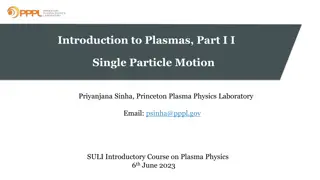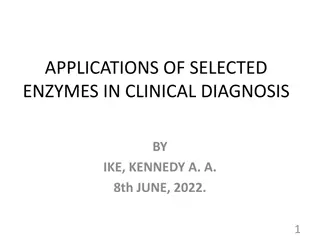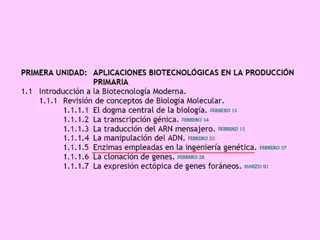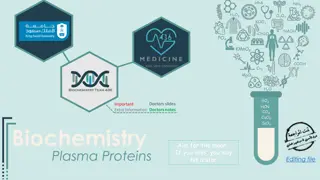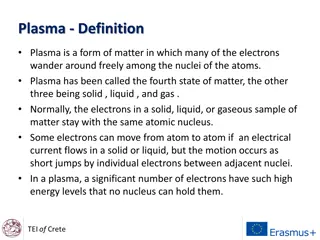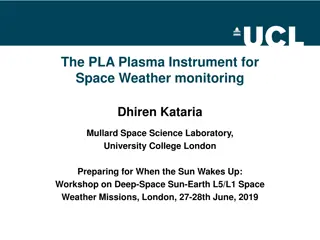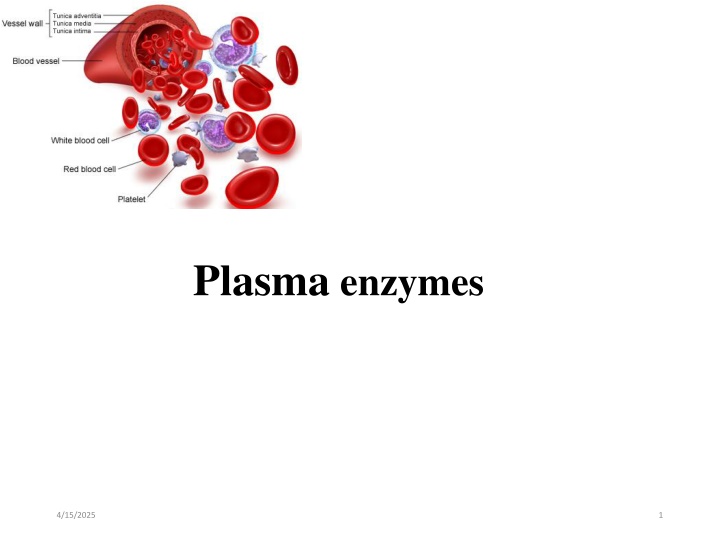
Plasma Enzymes: Functions, Classification, and Medical Importance
Blood plasma contains various enzymes, such as functional and non-functional enzymes, derived from cells and have high activity in plasma. Learn about the differences between these enzymes, their sources, and the medical importance of non-functional enzymes for diagnosing and prognosis of diseases affecting different organs.
Download Presentation

Please find below an Image/Link to download the presentation.
The content on the website is provided AS IS for your information and personal use only. It may not be sold, licensed, or shared on other websites without obtaining consent from the author. If you encounter any issues during the download, it is possible that the publisher has removed the file from their server.
You are allowed to download the files provided on this website for personal or commercial use, subject to the condition that they are used lawfully. All files are the property of their respective owners.
The content on the website is provided AS IS for your information and personal use only. It may not be sold, licensed, or shared on other websites without obtaining consent from the author.
E N D
Presentation Transcript
Plasma enzymes 4/15/2025 1
Plasma Enzymes Plasma derived Cell Derived:These enzymes have a high activity in cells & overflow into the plasma. These enzymes act on substrates in plasma & their activity is higher in plasma than cells. E.g., coagulation enzymes. Secretary enzymes Metabolic enzymes 4/15/2025 2
Blood plasma contains many enzymes which are classified into: Functional plasma enzymes 1. Nonfunctional plasma enzyme 2. 4/15/2025 3
Differences between functional and non functional enzymes Functional plasma enzymes Non functional plasma enzymes Present in plasma in higher concentrations in comparison to tissue Normally, Present in plasma in very low concentrations in comparison to tissue Concentration in plasma Have known functions No known functions Function Their substrates are always present in plasma Their substrates are absent from plasma Substrate liver Different organs .g. liver heart, skeletal muscles and brain Site of synthesis Decrease in liver disease Increase in different organ diseases Effect of disease Clotting factors e.g. Prothrombin Lipoprotein lipase, Pseudocholinesterase ALT, AST, CK, LDH, alkaline phosphatase, acid phosphatase and lipase Examples 4/15/2025 4
Small enzymes are present in the blood as a result of normal cell turnover. amounts of intracellular 'Normal' plasma enzyme levels reflect the balance between the rate of synthesis and release into plasma during cell turnover, and the rate of clearance from the circulation. The presence of elevated enzyme activity in the plasma may indicate tissue damage that is accompanied by increased release of intracellular enzymes 4/15/2025 5
Source of non functional enzymes Cell damage with the release of its content of enzymes into blood e.g. Myocardial infarction and viral hepatitis Obstruction of normal pathways e.g. Obstruction of bile duct increases alkaline phosphatase Increase of the enzyme synthesis e.g. bilirubin increases the rate of synthesis of alkaline phosphatase in obstructive liver disease Increased permeability of cell membrane as in hypoxia 4/15/2025 6
Medical importance of non functional enzymes Measurement of non functional enzymes is important for: 1. Diagnosis of diseases as disease of different organs cause elevation of different plasma enzymes 2. Prognosis of the disease we can follow up of the treatment by measuring plasma enzymes before and after treatment 4/15/2025 7
Disadvantages of enzyme assays A major disadvantage in the use of enzymes for the diagnosis of tissue damage is their lack of specificity to a particular tissue or cell type. Many enzymes are common to more than one tissue. This problem may be obviated to some extent in 2 ways: First, different tissues may contain (and thus release when they are damaged) two or more enzymes in different proportions Second, some enzymes exist in different forms (isoforms) 4/15/2025 8
Isoenzymes Isoenzymes (or isozymes) are a group of enzymes that catalyze the same reaction, but they differ in amino acid sequence Isoenzymes can be: produced by different genes (= true isozymes) produced by different posttranslational modification (= isoforms) found in different compartments of a cell found in different tissues of an organism can be oligomers of various subunits (monomers) 4/15/2025 9
Isoenzymes They differ in: electrophoretic mobility enzymatic properties physical properties (e.g heat stability) biochemical properties such as amino acid composition, immunological reactivities Because isoenzymes are originated from different tissues, their determination give more information than measurement of total enzyme activity in plasma 4/15/2025 10
Abnormal plasma enzyme activities Aspartate Transaminase (AST)/ Serum Glutamate oxaloacetate (SGOT) 4/15/2025 11
Diagnostic Significance Aspartate Transaminase (AST)/ Serum Glutamate oxaloacetate (SGOT) The clinical use of AST is limited mainly to the evaluation of hepatocellular disorders and skeletal muscle involvement. Post AMI (Acute Myocardial Infarction ) Rises 6 8 hours Peaks at 24 hours Returns to normal by day 5 AST levels are highest in acute hepatocellular disorders, viral hepatitis, cirrhosis. Viral hepatitis may reach 100 x ULN (Upper limit of Normal) 4/15/2025 12
Diagnostic Significance (cont.) Aspartate Transaminase (AST)/ Serum Glutamate oxaloacetate (SGOT) There are two isoenzyme fractions located in the cell cytoplasm and mitochondria, the cytoplasmic isoenzyme is predominant in serum while the mitochondrial one may be increased following cell necrosis. Isoenzyme analysis of AST is not routinely performed in the clinical laboratory. 4/15/2025 13
Abnormal plasma enzyme activities 1. Alanine Transaminase (ALT) / glutamate pyruvate transaminase (GPT) 4/15/2025 14
Abnormal plasma enzyme activities (Cont.) Alanine aminotransferase (ALT) Very high values are seen in acute hepatitis, either toxic or viral in origin. Both ALT and AST are increased in liver diseases, but ALT >AST. Moderate increase may be seen in chronic liver disease such as cirrhosis, and malignancy in liver. (AST/ALT) in normal conditions is 1.33 0.42. 4/15/2025 15
Abnormal plasma enzyme activities (Cont.) 2. Creatine Kinase (CK, CPK) 4/15/2025 16
Abnormal plasma enzyme activities (Cont.) Creatine Kinase (CK) High concentrations of CK in: skeletal muscle. cardiac muscle. brain tissue. Increased plasma CK activity is associated with damage to these tissues CK is especially useful to diagnose: AMI (indicator of muscle injury) Skeletal muscle diseases ( Muscular Dystrophy ) 4/15/2025 17
Abnormal plasma enzyme activities (Cont.) Creatine Kinase isoenzymes CK occurs in 3 isoenzymes, each is a dimer composed of 2 subunits (B & M): CK1 = BB, CK2 = MB and CK3 = MM Normal serum consists of: Approximately 94% to 100% CK-MM Values for the MB isoenzyme range from undetectable to trace (<6% of total CK). CK-BB is also present in small quantities Cardiac muscle CK is 80% , CK-MM and CK-MB is 20% 4/15/2025 18
Creatine Kinase isoenzymes Each CK isozyme shows a characteristic electrophoretic mobility. 4/15/2025 19
DiagnosticSignificance The value of CK isoenzyme separation can be used principally in detection of myocardial damage. increased CK MB ( > 6% of the total CK activity ) is a strong indication of AMI Post AMI CK-MB increases 4 8 hours Peaks at 12 - 24 hours Returns to normal 48 - 72 hours 4/15/2025 20
4/15/2025 21
Cardiac Disorders The CK rise the earliest, the LDH rise is latest The LDH elevations are present longer than those of CK and AST Fold elevation Days post infarction 4/15/2025 22
Abnormal plasma enzyme activities -Amylase Hydrolyses alpha-bonds of large alpha-linked polysaccharides such as starch and glycogen, yielding glucose and maltose It is used as a marker to detect acute pancreatitis and appendicitis 4/15/2025 23
Abnormal plasma enzyme activities Gamma-glutamyl-transferase (GGT) GGT is an enzyme found throughout the body, but it is mostly found in the liver. When the liver is damaged, GGT may leak into the bloodstream. High levels of GGT in the blood may be a sign of liver disease or damage to the bile ducts. A GGT test can't diagnose the specific cause of liver disease. So it is usually done along with or after other liver function tests, most often an alkaline phosphatase (ALP) test. 4/15/2025 24
Abnormal plasma enzyme activities Alkaline Phosphatase (ALP) Widely distributed throughout the body High levels are seen is liver, bone, placenta and intestine Physiological increases are been in pregnancy, due to the placental isoenzyme, and in childhood (when bones are growing), due to the bone isoenzyme. 4/15/2025 25
Diagnostic Significance Alkaline Phosphatase (ALP) In hepatobiliary obstruction, hepatocytes lining the biliary ducts induces the ALP synthesis. High levels of ALP is indicative of extrahepatic obstruction rather than intrahepatic obstruction In bones, the enzyme is derived from osteoblasts. Hence increased in bone diseases like rickets, osteomalacia, neoplastic diseases with bone metastases and healing fractures. 4/15/2025 26
Abnormal plasma enzyme activities (cont.) Acid Phosphatase (ACP) ACP is secreted by prostate cells, RBC, platelets and WBC. The main source of ACP is prostate gland and so can be used as a marker for prostate disease. Different forms of acid phosphatase are found in different organs, and their serum levels are used as a diagnostic for disease in the corresponding organs. 4/15/2025
Abnormal plasma enzyme activities LDH Lactate Dehydrogenase O O O O NADH+H+ NAD+ C C HC OH C O CH3 CH3 pyruvate lactate High activities in heart, liver, muscle, kidney, and RBC Lesser amounts: Lung, smooth muscle and brain 4/15/2025 28
Abnormal plasma enzyme activities LDH LDH occurs in 5 isoenzymes: LDH1 (H4), LDH2 (H3M), LDH3 (H2M2), LDH4 (HM3) and LDH5 (M4) 4/15/2025 29
Abnormal plasma enzyme activities LDH LDH occurs in 5 isoenzymes: LDH1 (H4): Cardiac , RBCs LDH2 (H3M): Cardiac , RBCs LDH3 (H2M2): Lung, spleen, pancreas LDH4 (HM3): Hepatic LDH5 (M4): Skeletal muscle 4/15/2025 30
Diagnostic Significance LDH is elevated in a variety of disorders: in cardiac, hepatic, skeletal muscle, and renal diseases, as well as in several hematologic and neoplastic disorders The highest levels of LD-1 are seen in pernicious anemia and hemolytic disorders LD-3 with pulmonary involvement LD-5 predominates with liver & muscle damage 4/15/2025 31
Diagnostic Significance In healthy individuals LD-2 is in highest quantity then LD-1, LD-3, LD-4 and LD-5 Heart problems: If problem is not MI, both LD1 and LD2 rise, with LD2 being greater than LD1 If problem is MI, LD1 is greater than LD2. 4/15/2025 32
Diagnostic Significance LDH-6 has been present in patients with arteriosclerotic cardiovascular failure Its appearance signifies a grave prognosis and impending death It is suggested, that LDH-6 may reflect liver injury secondary to severe circulatory insufficiency 4/15/2025 33
Abnormal plasma enzyme activities Lipase It is highly elevated in acute pancreatitis, and this persists for 7-14 days. Thus, lipase remains elevated longer than amylase. 4/15/2025 34
Enzymes as Tumor Markers Enzyme Serum acid phosphatase Serum Alkaline phosphatase Disease Prostrate cancer Metastasis in liver, jaundice due to carcinoma head of pancreas, osteoblastic metastasis in bones Advanced malignancies and Leukemias Cancer of urinary bladder Serum LDH - Glucuronidase Leucine Amino Peptidase (LAP) Liver cell carcinoma Neuron specific Enolase Malignancies of nervous tissue and brain 4/15/2025 35
Intracellular Distribution of Diagnostic Enzymes Liver Heart Pancreas Salivary Glands Bone Muscle Biliary Tract Prostate LDH5 ALT AST LDH1 AST CK LPS AMS AMS ALP CK ALP GGT ACP 4/15/2025 36
Major Enzymes of Clinical Significance Disease Enzyme Cardiac Disorders AST-LDH1-CK Hepatocellular Disorders Viral hepatitis: Hepatitis B & Hepatitis C. Toxic hepatitis: caused by chemicals & Toxins Skeletal Muscle Disorders ALT-AST-LDH5 CK-AST Biliary tract disorders ALP- GGT Bone Disorders ALP Acute Pancreatitis Lipase-AMS Salivary Gland Inflammation AMS 4/15/2025 37
THANK YOU ! 4/15/2025 38

